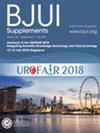Enhanced prognostic value of four-tier hybrid grading system in Ta non-muscle-invasive bladder cancer.
IF 3.7
2区 医学
Q1 UROLOGY & NEPHROLOGY
引用次数: 0
Abstract
OBJECTIVES To compare the predictive performance of the World Health Organization (WHO) 1973, WHO 2004/2022, the three-tier (low grade [LG]/Grade 1 [G1]-G2, high grade [HG]/G2, and HG/G3), and four-tier (LG/G1, LG/G2, HG/G2, and HG/G3) hybrid grading systems in Ta non-muscle-invasive bladder cancer (NMIBC), by evaluating recurrence-free survival (RFS) and progression-free survival (PFS). PATIENTS AND METHODS This retrospective multicentre study included 1233 patients with pTa NMIBC treated with transurethral resection of bladder tumour, eventually followed by intravesical instillations as determined by their physicians, between 2010 and 2023, across 18 Italian hospitals. Pathologists graded resected tissues using the WHO 1973, WHO 2004/2022 classifications, and hybrid three-tier (LG, HG/G2, HG/G3) and four-tier (LG/G1, LG/G2, HG/G2, HG/G3) systems. Kaplan-Meier curves estimated RFS and PFS. Discriminative performance was assessed using Harrell's concordance index (C-index). RESULTS Among 1233 patients with pTa NMIBC, 890 were classified as LG and 343 as HG according to the WHO 2004/2022 grading system, while 586, 405, and 242 were categorised as G1, G2, and G3, respectively, under the WHO 1973 system. With a median (interquartile range) follow-up of 26 (14-48) months, 418 patients experienced recurrence, including 184 with HG recurrence and 42 who progressed to MIBC. The C-index values for RFS were 0.60, 0.56, 0.57, and 0.61 for the WHO 1973, WHO 2004/2022, hybrid three-tier, and four-tier grading systems, respectively. For progression, the C-index values were 0.80, 0.74, 0.75, and 0.81 across the same systems, underscoring the superior predictive capacity of the four-tier classification. Nonetheless, the low number of MIBC progression events limits the robustness of these analyses. CONCLUSION Our findings highlight the superior prognostic accuracy of the four-tier hybrid classification in predicting recurrence and progression in patients with stage Ta NMIBC. By combining strengths from the WHO 1973 and 2004/2022, this hybrid model shows promise as tool for enhancing NMIBC patient management in clinical practice.四级混合分级系统对非肌肉浸润性膀胱癌预后的增强价值。
目的通过评估无复发生存期(RFS)和无进展生存期(PFS),比较世界卫生组织(WHO) 1973年、WHO 2004/2022年、三级(低分级[LG]/ 1级[G1]-G2、高分级[HG]/G2和HG/G3)和四级(LG/G1、LG/G2、HG/G2和HG/G3)混合分级系统对非肌肉浸润性膀胱癌(NMIBC)的预测效果。患者和方法本回顾性多中心研究纳入了2010年至2023年间意大利18家医院的1233例pTa NMIBC患者,经尿道膀胱肿瘤切除术治疗,最终由医生决定膀胱内灌注。病理学家使用WHO 1973、WHO 2004/2022分类以及混合三层(LG、HG/G2、HG/G3)和四层(LG/G1、LG/G2、HG/G2、HG/G3)系统对切除组织进行分级。Kaplan-Meier曲线估计RFS和PFS。采用Harrell’s concordance index (C-index)评价辨别性表现。结果1233例pTa NMIBC患者中,按WHO 2004/2022分级体系分为LG级890例,HG级343例,按WHO 1973分级体系分为G1级586例,G2级405例,G3级242例。在26(14-48)个月的中位(四分位数范围)随访中,418例患者出现复发,其中184例HG复发,42例进展为MIBC。WHO 1973、WHO 2004/2022、混合三级和四级分级系统的RFS c指数值分别为0.60、0.56、0.57和0.61。对于进展,同一系统的c -指数值分别为0.80、0.74、0.75和0.81,强调了四层分类的优越预测能力。然而,低数量的MIBC进展事件限制了这些分析的稳健性。结论:我们的研究结果强调了四层混合分类在预测Ta期NMIBC患者复发和进展方面的优越预后准确性。通过结合世卫组织1973年和2004/2022年的优势,这种混合模式有望成为在临床实践中加强NMIBC患者管理的工具。
本文章由计算机程序翻译,如有差异,请以英文原文为准。
求助全文
约1分钟内获得全文
求助全文
来源期刊

BJU International
医学-泌尿学与肾脏学
CiteScore
9.10
自引率
4.40%
发文量
262
审稿时长
1 months
期刊介绍:
BJUI is one of the most highly respected medical journals in the world, with a truly international range of published papers and appeal. Every issue gives invaluable practical information in the form of original articles, reviews, comments, surgical education articles, and translational science articles in the field of urology. BJUI employs topical sections, and is in full colour, making it easier to browse or search for something specific.
 求助内容:
求助内容: 应助结果提醒方式:
应助结果提醒方式:


